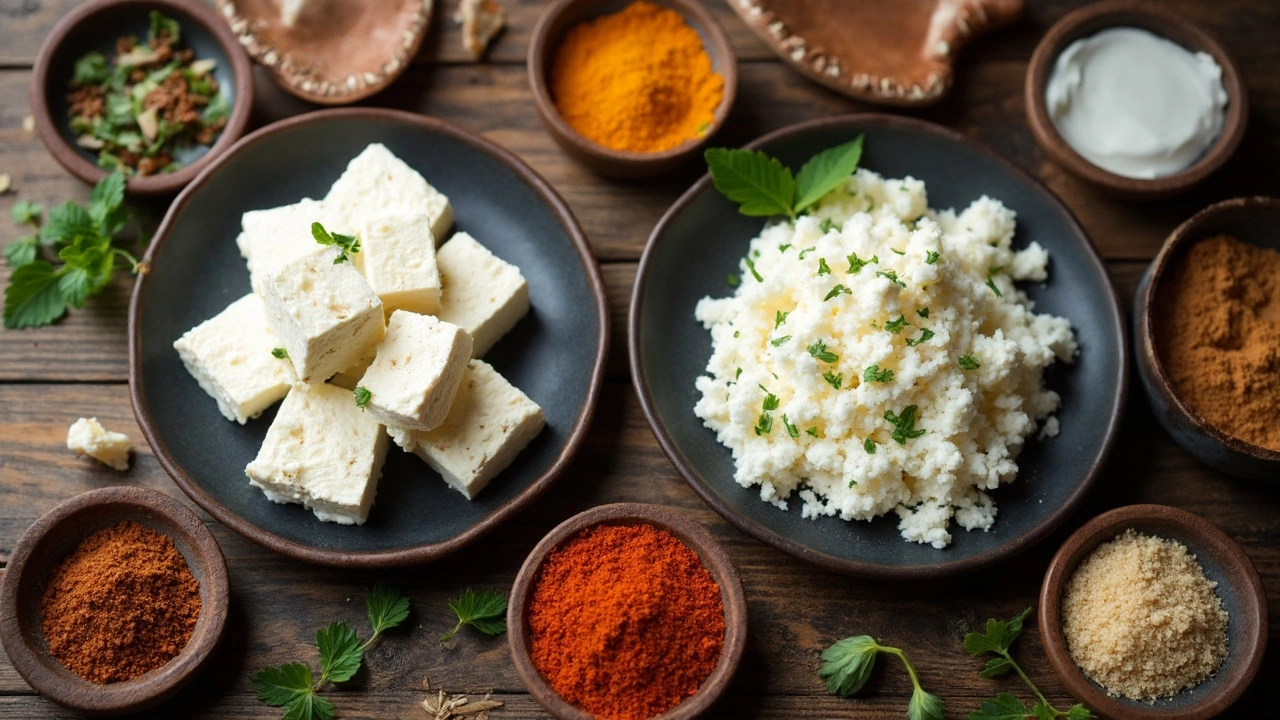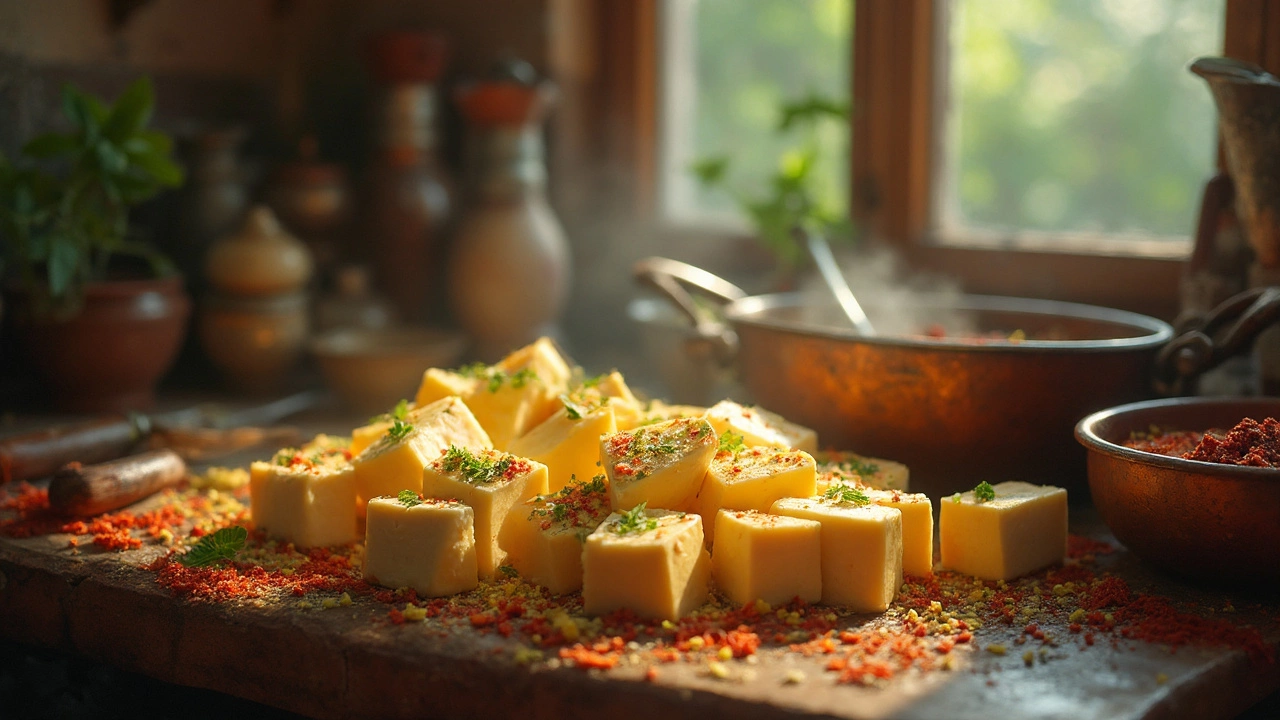So, you've heard of paneer, right? That delightful Indian cheese that pops up in so many delicious dishes. But here's a common question: What do you call paneer in English? Many folks quickly jump to 'cottage cheese,' and while they're not entirely wrong, it's not the full story you need to know.
Cottage cheese might look similar at first glance with its soft, crumbly texture, yet if you've ever tasted both, you'd know they're distinct. The big difference? It's all about how they're made. Paneer doesn't melt, making it perfect for grilling or frying, unlike its slightly creamier Western cousin.
Curious about making your own paneer at home? It's simpler than you'd think and offers way more flavor than store-bought options. Plus, it's a fresh experience when you sink your teeth into a meal knowing you crafted one of its key ingredients yourself!
- Paneer: An Overview
- Comparing Paneer to Cottage Cheese
- Why Paneer Isn’t Exactly Cottage Cheese
- Making Homemade Paneer
- Paneer in Everyday Cooking
- Tips for Storing and Using Paneer
Paneer: An Overview
Packed with protein and quite the versatile ingredient, paneer is a staple in many Indian households. It's that soft, white cheese you'll find in everything from creamy curries to sizzling skewers. But what's at its heart? It's just milk and a souring agent—typically lemon juice or vinegar.
Unlike many cheeses, paneer uses an acid to curdle the milk. This method gives it a unique structure, keeping it firm even when cooked. A huge bonus is that paneer doesn’t melt, which makes it a top choice for hot dishes where a bit of texture is desired. Who doesn't love biting into a well-charred piece of paneer tikka?
Why It's So Popular
Paneer's popularity isn't just due to its taste, though that's a big part of it. Its rich yet mild flavor soaks up spices beautifully, making it a canvas for countless dishes. Plus, for vegetarians, it's a godsend. Laden with protein, it's a way to pack nutrients into meat-free meals.
Nutritional Aspect
If you're keeping an eye on nutrition, here's a quick glance at what paneer offers per 100g:
| Nutrient | Amount |
|---|---|
| Calories | 265 |
| Protein | 18g |
| Fat | 20g |
| Calcium | 208mg |
With its balance of protein and fats, it's no wonder paneer finds itself a favorite in everything from breakfast to dinner.
Paneer is a delightful cheese that's easy to make and incredibly versatile in cooking, providing both flavor and nutrition.
Comparing Paneer to Cottage Cheese
When you place paneer and cottage cheese side by side, they might seem pretty similar, but let's break down their key differences. First off, their origins: paneer hails from Indian cuisine, while cottage cheese is commonly found in Western diets. They often swap names in conversations, but they have distinct characteristics.
The Making Process
Paneer is made by curdling heated milk with an acid like lemon juice or vinegar. It's then drained, and the curds are pressed into blocks. This process makes it non-melting, so paneer holds its shape when cooked. Handy, right?
On the flip side, cottage cheese is made using a lactic starter that leaves a bit of whey to keep the final product creamy. Unlike paneer, it's not pressed, giving it that unique, moist, and often lumpy texture.
Texture and Flavor
The texture difference is pretty apparent upon tasting. Paneer is firm with a slightly chewy feel, making it excellent for grilling or frying without losing its form. Cottage cheese is softer, more granular, and often a bit salty, making it a go-to for salads and dips.
Nutritional Value
Both have their nutritional perks. Paneer is typically richer in proteins and fats compared to cottage cheese, but it also packs more calories. Cottage cheese, being lower in fats due to its moisture content, might be preferred if you're watching your diet.
| Nutrient | Paneer | Cottage Cheese |
|---|---|---|
| Protein (per 100g) | 18g | 11g |
| Fat (per 100g) | 20g | 4g |
| Calories (per 100g) | 265 | 98 |
So, when deciding whether to use paneer or cottage cheese, it's all about what you're cooking and what taste you're after. Whether you're crafting an Indian curry or mixing up a fresh salad, knowing these differences helps you make the best choice!
Why Paneer Isn’t Exactly Cottage Cheese
At a glance, paneer and cottage cheese might appear similar, but there are some really key differences that set them apart. The primary one lies in how they're made. Paneer is a fresh cheese, created by curdling milk with a souring agent like lemon juice or vinegar. This method gives paneer its unique non-melting quality, making it perfect for frying.
Cottage cheese, on the other hand, is curdled using rennet or a bacterial culture, which contributes to its more liquid consistency and slightly tangier taste. Because it retains whey, it tends to be less firm and more crumbly than paneer.
The Texture and Cooking Difference
Texture plays a huge role here. Paneer can be cut into cubes and used in cooking much like tofu, retaining its shape and absorbing flavors from sauces and spices. Cottage cheese, which crumbles more easily, often wouldn’t hold up in similar dishes.
“Paneer’s ability to hold its form even under heat is what makes it a star in many Indian curries,” explains Chef Anusha Singh from the Culinary Institute of India.
Moreover, paneer has a mild, milky taste that complements spices well. This neutrality is actually one of its strongest points. Meanwhile, the tang of cottage cheese makes it a better fit for salads and spreads.
Nutritional Perspective
When it comes to nutrition, both cheeses offer a good source of protein, though paneer usually contains slightly more. A 100g serving of paneer typically contains around 18g of protein compared to cottage cheese’s 11g, making paneer a popular choice for vegetarians seeking protein alternatives.
| Cheese Type | Protein (per 100g) | Calcium (per 100g) |
|---|---|---|
| Paneer | 18g | 300mg |
| Cottage Cheese | 11g | 83mg |
Understanding these differences can really enhance your cooking game, helping you decide the best use for each cheese in your culinary creations. Remember, both bring something special to the table, so it’s worth experimenting to see which cheese suits your dish the best.

Making Homemade Paneer
If you've ever felt up for a kitchen adventure, making homemade paneer is a fantastic place to start. You'll only need a few basic ingredients and a bit of patience.
What You Need
- 1 liter of fresh whole milk
- 2-3 tablespoons of lemon juice or vinegar
- A pinch of salt (optional)
- A cheesecloth or a clean, thin kitchen towel
- A colander and a large pot
Step-by-Step Process
- Boil the Milk: In a large pot, bring the milk to a gentle boil. Stir occasionally to prevent it from scorching on the bottom.
- Add the Acid: Once it's at a boil, lower the heat and slowly add lemon juice or vinegar while stirring gently. You'll see the milk start to curdle as the whey separates.
- Strain the Curds: Place a cheesecloth over a colander, and pour the curdled milk through it. Rinse the curds with cold water to wash out the lemon or vinegar flavor.
- Drain and Press: Gather the edges of the cheesecloth, twist them together to extract excess moisture, and shape into a block. Weigh it down with something heavy and let it sit for about 30 minutes.
- Set the Paneer: After pressing, you can cut paneer into cubes and use it right away or store it in the fridge for later.
And that's really all there is to it! Once you've got your homemade paneer, you can toss it into your favorite curry, grill it, or even eat it plain. It's fresh, it's delicious, and you'll get major bragging rights next time you're cooking Indian at home.
Paneer in Everyday Cooking
If you've got some paneer in the fridge, you're already halfway to your next tasty meal. This versatile ingredient can find its way into almost any dish. Whether you're aiming for something light or looking for a hearty addition to your table, there's a way to incorporate paneer.
Quick and Easy Meals
Need a fast dinner fix? Toss paneer into a stir-fry with your favorite veggies, a splash of soy sauce, and some spices. The great thing about paneer is its ability to soak up flavors, so the dish will always have a burst of taste.
"Paneer is a colorful centerpiece to any meal, adding protein and texture effortlessly," says renowned chef Madhur Jaffrey.
Curries and Stews
Of course, the classic choice is to have paneer in rich, velvety curries. Pair it with spinach for a delicious Palak Paneer or in tomato gravy for the famous Paneer Butter Masala. These dishes bring out the creamy side of paneer and make for a comforting meal.
Grilled Delights
For a different take, try grilling paneer chunks with spices for a fun appetizer or side. It's like an Indian barbecue treat! Just marinate in yogurt and spices, pop them on skewers, and grill until they're golden. Serve up with some chutney and enjoy!
- Add paneer cubes to salads for a protein boost.
- Make a paneer sandwich or toast for a quick snack.
- Stir it into your pasta for something unexpected.
Nutritional Value
Wondering about the health aspects? Paneer is a great source of protein, especially for vegetarians. It's also packed with calcium and supports strong bones.
Looking for a nutritious staple? Try having about 100g of paneer in your dishes a few times a week—it keeps things balanced and tasty!
Tips for Storing and Using Paneer
If you've made or bought paneer, knowing how to store it is key to keeping it fresh and tasty. Let’s get straight into it so your efforts don’t go to waste.
Storing Paneer Properly
Paneer is best when fresh, but sometimes we need to store it for later. Here’s how:
- Refrigeration: Wrap paneer in a damp cloth and pop it into an airtight container. This should keep it fresh for up to a week.
- Freezing: If you need it for a longer period, cut the paneer into cubes, place it in a zip-lock bag, and freeze. It'll last about two months. Just remember, frozen paneer may be slightly crumbly when thawed.
Using Paneer in Cooking
Wondering how to add a bit of that homemade paneer magic to your meals? Try these ideas:
- Stir-Fry: Cube your paneer and stir-fry it with veggies and your favorite spices. It's quick and satisfying.
- Grilled: Marinate paneer cubes in a mix of spices and yogurt. Skewer and grill them for a delicious snack.
- Curry: Paneer works beautifully in rich, flavorful curries. Just substitute it for meat and let the spices do the talking.
And here’s a neat trick: Soak paneer in warm water before cooking. It helps in softening and improving its texture, especially if you’re working with frozen paneer.
Extending Shelf Life
| Technique | Effect |
|---|---|
| Refrigeration with Brine | Retains moisture and flavor for up to 10 days. |
| Vacuum Sealing | Extends shelf life up to several months. |
So, whether you're whipping up a quick weeknight dinner or planning a lavish spread, storing your paneer right and knowing how to use it can make all the difference.
